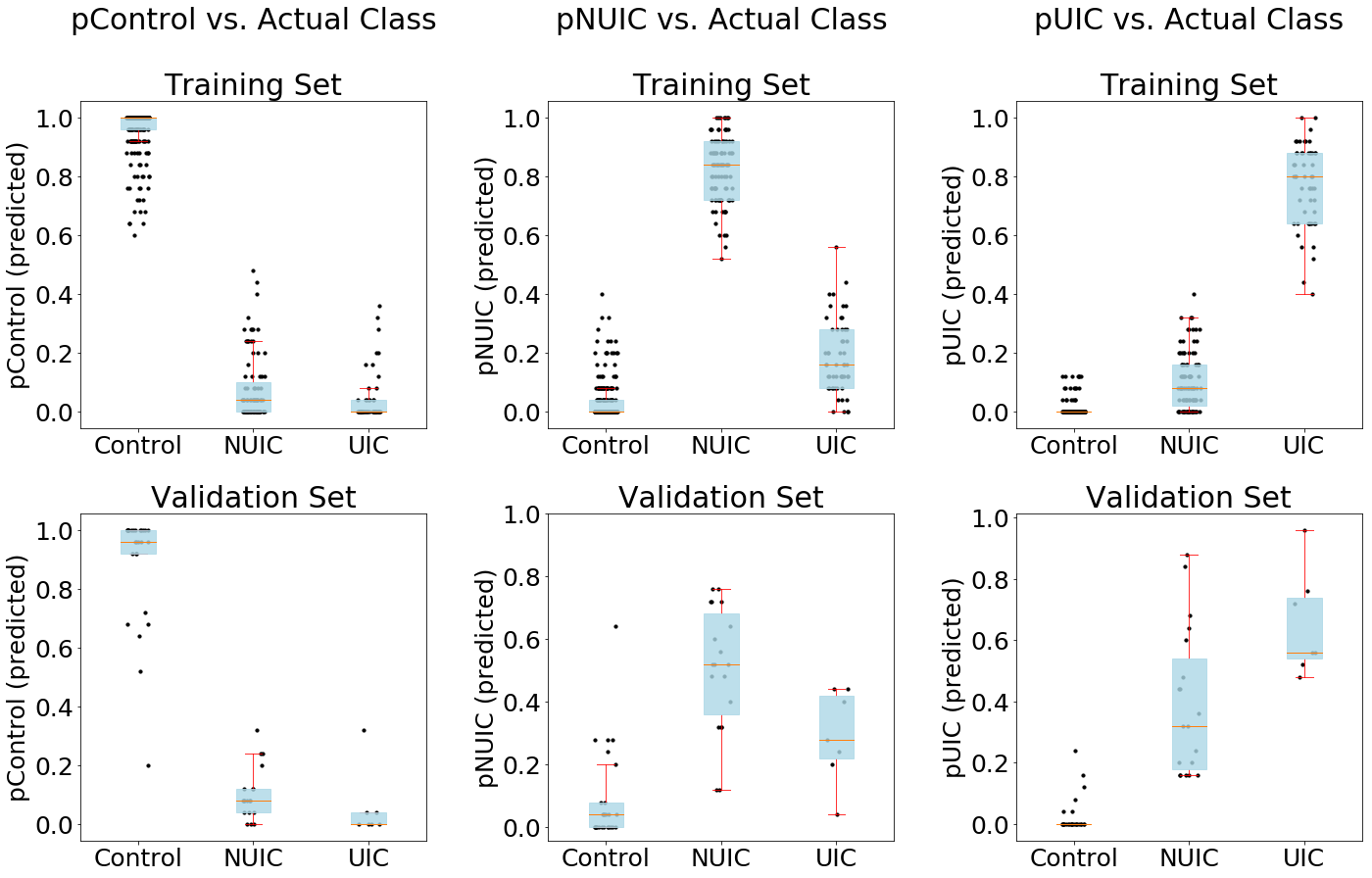Back
Introduction: IC/BPS is a multifactorial syndrome of severe pelvic and genitalia pain. Diagnosis of IC/BPS currently utilizes patient-reported outcomes (PRO) instruments to assess symptoms, however overlapping symptoms with other diseases can delay proper diagnosis and symptom relief. The objective of this study is to develop an improved IC/BPS risk classification, using machine learning algorithm to leverage both urine inflammatory cytokines and PROs.
Methods: A national crowdsourcing resulted in 442 clinical urine samples consisting of 153 IC patients (146 female, 7 male), and 289 asymptomatic age-matched controls (155 female, 134 male) with corresponding PRO pain and symptom scores. This included 53 patients with a bladder-centric dysfunction as defined by presence of Hunner’s lesions. An independent validation cohort was also collected. Urinary cytokine levels were determined using Luminex assay. A predictive classification model, termed the Personalized Inflammation Symptom (PIS) Score, was generated from this data into three classification: 1) normal/low IC risk; 2) moderate to high risk for IC with bladder centric dysfunction; and 3) moderate to high risk of IC without bladder centric dysfunction.
Results: In the training set, the PIS Score correctly classified all controls, all IC patients without Hunner’s lesions, and 98% (52/53) IC patients with Hunner’s lesions. In the independent validation set, the PIS Score correctly classified 26 of 27 (96%), 14 of 19 (73.7%) IC without Hunner’s lesions, and all IC patient’s with Hunner’s lesions.
Conclusions: In one of the largest collection of urine samples of IC/BPS patients from across all 50 states of US, two key findings emerged: 1) A standardized LUMINEX laboratory urine assay based IC-Risk Score is comparable to ICSI/ICPI or pain VAS in accuracy of diagnosis; 2) PIS, using laboratory-based objective data in combination with PROs, improves the AUC and accuracy of IC/BPS diagnosis. An objective laboratory test for IC/BPS, similar to tests that have been developed to improve cancer diagnosis, may help expand access, accelerate proper diagnosis, and improve care for IC/BPS, a disease with great unmet needs. SOURCE OF
Funding: This work was supported by the Office of the Assistant Secretary of Defense for Health Affairs through the Technology/Therapeutic Development Research Program under Award No. W81XWH-19-1-0288. The opinions, interpretations, conclusions, and recommendations are those of the authors and are not necessarily endorsed by the Department of Defense.

Moderated Poster Session
Session: MP39: Health Services Research: Value of Care, Cost & Outcomes Measures
MP39-01: Classification of Interstitial Cystitis/Bladder Pain Syndrome (IC/BPS) Using a Machine Learning Based Symptom Score Constructed on Inflammatory Urine Cytokines and Patient-Reported Outcomes Improves Diagnosis
Saturday, April 29, 2023
1:00 PM – 3:00 PM CST
Location: S404C

Michael B. Chancellor, MD
Professor of Urology
Beaumont Health
Poster Presenter(s)
Introduction: IC/BPS is a multifactorial syndrome of severe pelvic and genitalia pain. Diagnosis of IC/BPS currently utilizes patient-reported outcomes (PRO) instruments to assess symptoms, however overlapping symptoms with other diseases can delay proper diagnosis and symptom relief. The objective of this study is to develop an improved IC/BPS risk classification, using machine learning algorithm to leverage both urine inflammatory cytokines and PROs.
Methods: A national crowdsourcing resulted in 442 clinical urine samples consisting of 153 IC patients (146 female, 7 male), and 289 asymptomatic age-matched controls (155 female, 134 male) with corresponding PRO pain and symptom scores. This included 53 patients with a bladder-centric dysfunction as defined by presence of Hunner’s lesions. An independent validation cohort was also collected. Urinary cytokine levels were determined using Luminex assay. A predictive classification model, termed the Personalized Inflammation Symptom (PIS) Score, was generated from this data into three classification: 1) normal/low IC risk; 2) moderate to high risk for IC with bladder centric dysfunction; and 3) moderate to high risk of IC without bladder centric dysfunction.
Results: In the training set, the PIS Score correctly classified all controls, all IC patients without Hunner’s lesions, and 98% (52/53) IC patients with Hunner’s lesions. In the independent validation set, the PIS Score correctly classified 26 of 27 (96%), 14 of 19 (73.7%) IC without Hunner’s lesions, and all IC patient’s with Hunner’s lesions.
Conclusions: In one of the largest collection of urine samples of IC/BPS patients from across all 50 states of US, two key findings emerged: 1) A standardized LUMINEX laboratory urine assay based IC-Risk Score is comparable to ICSI/ICPI or pain VAS in accuracy of diagnosis; 2) PIS, using laboratory-based objective data in combination with PROs, improves the AUC and accuracy of IC/BPS diagnosis. An objective laboratory test for IC/BPS, similar to tests that have been developed to improve cancer diagnosis, may help expand access, accelerate proper diagnosis, and improve care for IC/BPS, a disease with great unmet needs. SOURCE OF
Funding: This work was supported by the Office of the Assistant Secretary of Defense for Health Affairs through the Technology/Therapeutic Development Research Program under Award No. W81XWH-19-1-0288. The opinions, interpretations, conclusions, and recommendations are those of the authors and are not necessarily endorsed by the Department of Defense.

